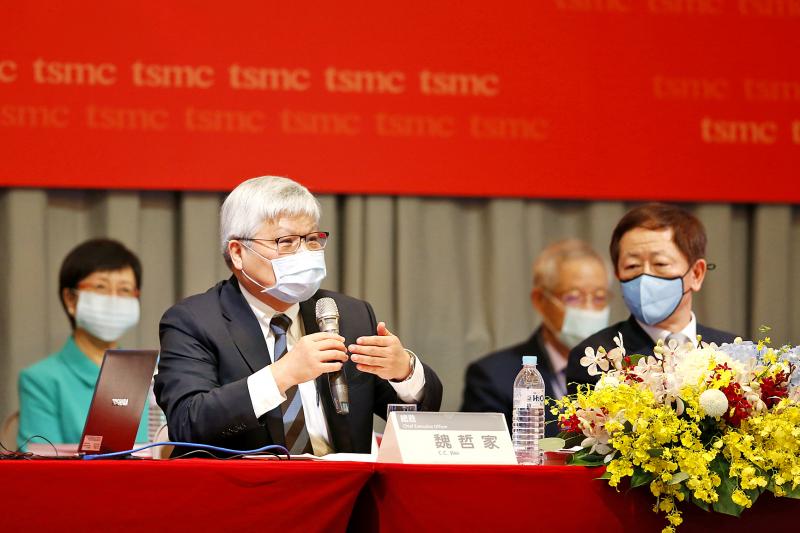Taiwan Semiconductor Manufacturing Co (TSMC, 台積電) yesterday left its record capital expenditures plan unchanged for this year as robust client demand for 5-nanometer technology is expected to quickly fill a capacity hole after the US government announced restrictions against supplying Huawei Technologies Co (華為).
The world’s biggest contract chipmaker had said that it planned to spend between US$15 billion and US$16 billion this year primarily to expand capacity for advanced 5-nanometer and 7-nanometer technologies, and develop 3-nanometer technology.
“It looks like we will see a hole in demand for 5-nanometer capacity this year, but I believe this hole will soon be filled,” TSMC chairman Mark Liu (劉德音) told a media briefing after the company’s annual shareholders’ meeting in Hsinchu.

Photo: Ashley Pon, Bloomberg
If HiSilicon Technologies Co (海思), a semiconductor arm of Huawei, cancels orders, TSMC’s other clients would make up for that lost capacity, as they have approached the company about placing orders, Liu said in response to shareholder concern that the US’ latest chip supply restrictions on foreign chipmakers might put a damper on TSMC’s revenue growth.
TSMC’s 5-nanometer technology is the most advanced technology available, and HiSilicon, Apple Inc and Advanced Micro Devices Inc are typically early adopters of the company’s most advanced technologies.
“We are not going to alter our capital spending for this year, nor are we going to revise our revenue growth outlook for this year,” Liu said.
However, he said that the chipmaker is facing challenges due to US-China trade tensions.
TSMC in April slightly trimmed its revenue growth for this year to an annual expansion of 15 to 18 percent, down from a previous forecast of more than 17 percent, as the COVID-19 pandemic dampened demand for smartphones.
The pandemic has not sidetracked the chipmaker’s upgrade to 5-nanometer and 3-nanometer technologies, Liu said.
Mass production of 3-nanometer technology would start as planned in the second half of 2022, with 4-nanometer technology, an enhanced version of 5-nanometer technology, being mass produced in 2023, Liu added.
Officials also discussed a plan to build a US$12 billion fab in Arizona, as shareholders expressed concern that the investment would weigh on profitability.
Subsidies from the US federal and state governments would be a determining factor in the final decision to build the fab, Liu said, adding that TSMC has not yet signed a formal agreement with US authorities.
“If the US [federal and state] governments are willing to cover our running costs, our profit margin will not be affected,” Liu said.
In such a case, the Arizona fab would definitely make a profit, as its gross margin would be similar to that of the corporate level of the company, he said.
TSMC said that the US subsidies are a crucial component of its plan to construct the fab, adding that it hopes subsidies would make US manufacturing costs comparable to those in Taiwan and China.
The firm’s raw material suppliers, such as chemicals and special gas companies, also plan to build production lines in Arizona, where Intel Corp and several other semiconductor firms have built a solid supply chain, Liu said.
TSMC shares yesterday closed up 0.31 percent at NT$319 in Taipei trading.

Shares in Taiwan closed at a new high yesterday, the first trading day of the new year, as contract chipmaker Taiwan Semiconductor Manufacturing Co (TSMC, 台積電) continued to break records amid an artificial intelligence (AI) boom, dealers said. The TAIEX closed up 386.21 points, or 1.33 percent, at 29,349.81, with turnover totaling NT$648.844 billion (US$20.65 billion). “Judging from a stronger Taiwan dollar against the US dollar, I think foreign institutional investors returned from the holidays and brought funds into the local market,” Concord Securities Co (康和證券) analyst Kerry Huang (黃志祺) said. “Foreign investors just rebuilt their positions with TSMC as their top target,

REVENUE PERFORMANCE: Cloud and network products, and electronic components saw strong increases, while smart consumer electronics and computing products fell Hon Hai Precision Industry Co (鴻海精密) yesterday posted 26.51 percent quarterly growth in revenue for last quarter to NT$2.6 trillion (US$82.44 billion), the strongest on record for the period and above expectations, but the company forecast a slight revenue dip this quarter due to seasonal factors. On an annual basis, revenue last quarter grew 22.07 percent, the company said. Analysts on average estimated about NT$2.4 trillion increase. Hon Hai, which assembles servers for Nvidia Corp and iPhones for Apple Inc, is expanding its capacity in the US, adding artificial intelligence (AI) server production in Wisconsin and Texas, where it operates established campuses. This

US President Donald Trump on Friday blocked US photonics firm HieFo Corp’s US$3 million acquisition of assets in New Jersey-based aerospace and defense specialist Emcore Corp, citing national security and China-related concerns. In an order released by the White House, Trump said HieFo was “controlled by a citizen of the People’s Republic of China” and that its 2024 acquisition of Emcore’s businesses led the US president to believe that it might “take action that threatens to impair the national security of the United States.” The order did not name the person or detail Trump’s concerns. “The Transaction is hereby prohibited,”

Garment maker Makalot Industrial Co (聚陽) yesterday reported lower-than-expected fourth-quarter revenue of NT$7.93 billion (US$251.44 million), down 9.48 percent from NT$8.76 billion a year earlier. On a quarterly basis, revenue fell 10.83 percent from NT$8.89 billion, company data showed. The figure was also lower than market expectations of NT$8.05 billion, according to data compiled by Yuanta Securities Investment and Consulting Co (元大投顧), which had projected NT$8.22 billion. Makalot’s revenue this quarter would likely increase by a mid-teens percentage as the industry is entering its high season, Yuanta said. Overall, Makalot’s revenue last year totaled NT$34.43 billion, down 3.08 percent from its record NT$35.52